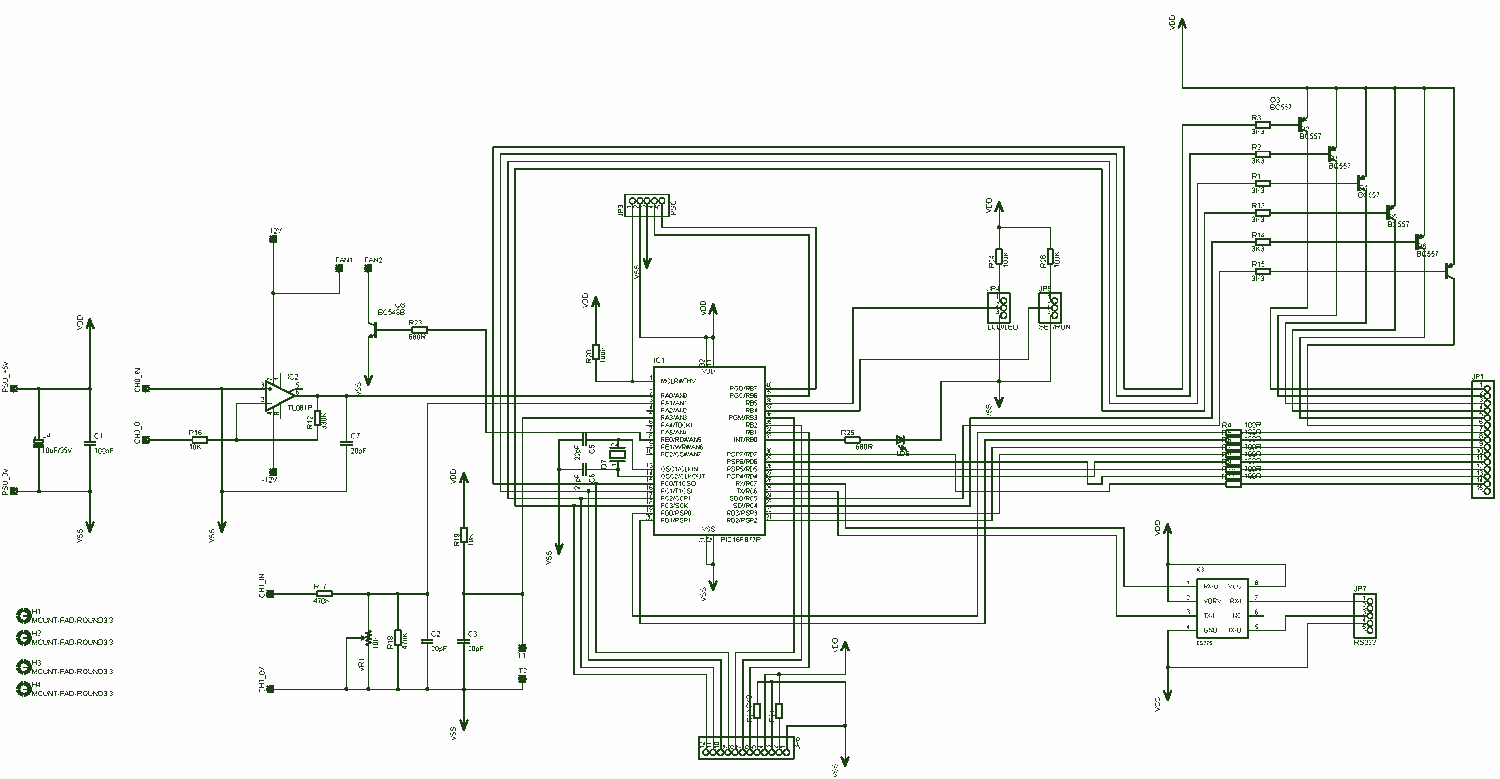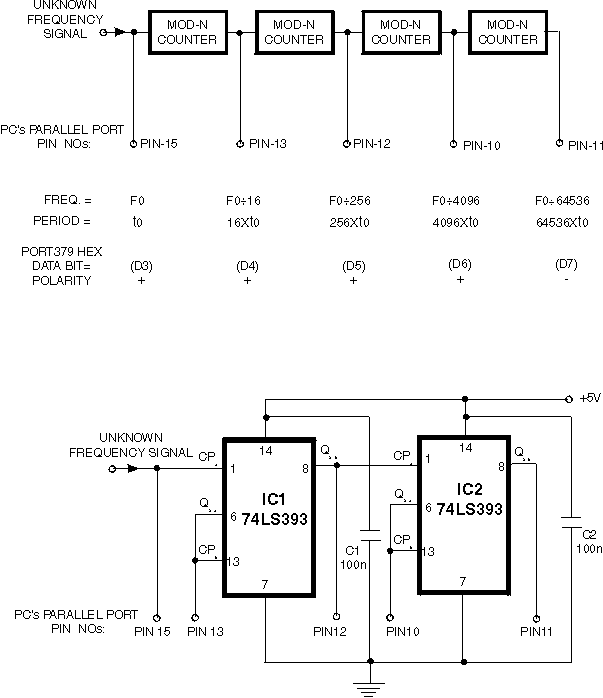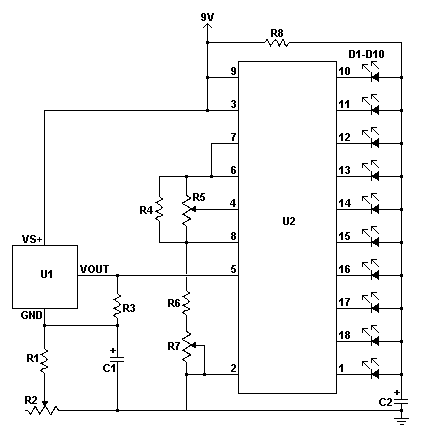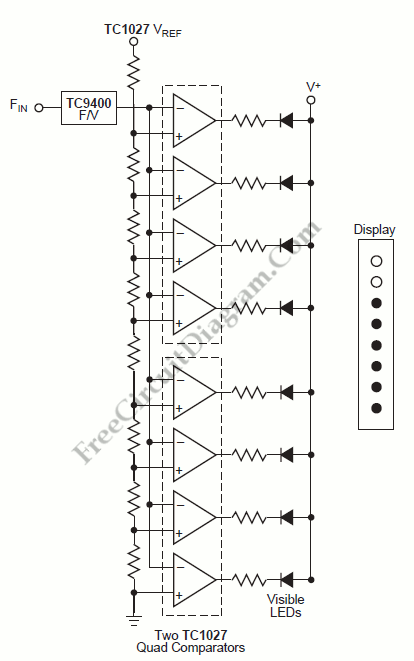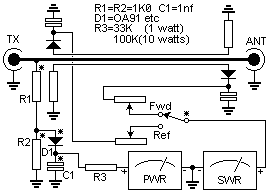
Linear Resistance Meter

Most analog multimeters can measure resistance across a wide range of values; however, they can be inconvenient due to their reverse reading scale, which is also non-linear. This can lead to poor accuracy, especially at the high-value end of each range. This resistance meter features five ranges with a forward-reading linear scale for each range. The full-scale values for the five ranges are 1K, 10K, 100K, 1M, and 10M, allowing for reasonably accurate measurements from tens of ohms to ten megohms. Linear scale resistance meters, including this design, operate on the principle that when a resistance is connected to a constant current source, the voltage across that resistance is proportional to its value. For instance, feeding a 1K resistor from a 1 mA current source results in a voltage of 1 volt across the resistor (1000 ohms divided by 0.001 amps equals 1 volt). Similarly, for resistance values of 100 ohms and 10K, the voltages would be 0.1 volts (100 ohms divided by 0.001 amps) and 10 volts (10000 ohms divided by 0.001 amps), respectively. Therefore, the voltage across the resistor is proportional to its resistance, allowing a voltmeter calibrated in resistance to display a linear scale. It is crucial that the voltmeter does not draw significant current, as this could alter the current supplied to the test resistor and affect linearity; thus, a high-impedance voltmeter circuit is necessary. The complete circuit diagram of the Linear Resistance Meter is illustrated in Figure 1. The constant current generator consists of IC1a and Q1. R1, D1, and D2 form a simple voltage regulator circuit, providing a potential of just over 1.2 volts to the non-inverting input of IC1a. There is 100% negative feedback from the emitter of Q1 to the inverting input of IC1a, stabilizing Q1's emitter at slightly more than 1.2 volts below the positive supply rail potential. Switch S3a offers five switched emitter resistances for Q1, resulting in five switched emitter currents. Switch S3b provides five reference resistors across T1 and T2 via S2 to establish full-scale deflection on each range using VR1. Since the emitter and collector currents of a high-gain transistor like the BC179 used in Q1 are nearly identical, this configuration also yields five switched collector currents. By reducing the output current by a factor of 10 with each clockwise movement of S3a, five distinct measuring ranges are achieved. Resistors R2 to R6 must be of close tolerance to ensure accuracy across all ranges. The high-impedance voltmeter section employs IC1b with 100% negative feedback from the output to the inverting input, ensuring unity voltage gain from the non-inverting input to the output. The output of IC1b drives a simple voltmeter circuit using VR1 and M1, with VR1 adjusted to provide the correct full-scale resistance values. The CA3240E device used for IC1 is a dual op-amp featuring a MOS input stage and a class A output stage, enabling operation with inputs and outputs down to the negative supply rail voltage. This characteristic is advantageous in many circuits, including this one, as it allows for the use of a single supply rail instead of a dual balanced supply, which is often required to permit the op-amp's output to reach the 0-volt rail. The CA3240E's MOS input stage results in a very high input impedance (approximately 1.5 megaohms), ensuring minimal loading effect on the circuit being measured.Most analogue multimeters are capable of measuring resistance over quite a wide range of values, but are rather inconvenient in use due to the reverse reading scale which is also non-linear. This can also give poor accuracy due to cramping of the scale that occurs at the high value end of each range.
This resistance meter has 5 ranges and it has a forward reading linear scale on each range. The full-scale values of the 5 ranges are 1K, 10K, 100K, 1M &10M respectively and the unit is therefore capable of reasonably accurate measurements from a few tens of ohms to ten Megohms. Most linear scale resistance meters including the present design, work on the principle that if a resistance is fed from a constant current source the voltage developed across that resistance is proportional to its value.
For example, if a 1K resistor is fed from a 1 mA current source from OhmG ‚¬ s Law it can be calculated that 1 volt will be developed across the resistor (1000 Ohms divided by 0. 001 amps = 1 volt). Using the same current and resistance values of 100 ohms and 10K gives voltages of 0. 1volts (100 ohms / 0. 001amps = 0. 1volts) and 10 volts (10000 ohms / 0. 001amps = 10 volts). Thus the voltage developed across the resistor is indeed proportional to its value, and a voltmeter used to measure this voltage can in fact be calibrated in resistance, and will have the desired forward reading linear scale.
One slight complication is that the voltmeter must not take a significant current or this will alter the current fed to the test resistor and impair linearity. It is therefore necessary to use a high impedance voltmeter circuit. The full circuit diagram of the Linear Resistance Meter is given in Figure 1. The constant current generator is based on IC1a and Q1. R1, D1 and D2 form a simple form a simple voltage regulator circuit, which feeds a potential of just over 1.
2 volts to the non-inverting input of IC1a. There is 100% negative feedback from the emitter of Q1 to the inverting input of IC1a so that Q1G ‚¬ s emitter is stabilised at the same potential as IC1aG ‚¬ s non-inverting input. In other words it is stabilised a little over 1. 2 volts below the positive supply rail potential. S3a gives 5 switched emitter resistances for Q1, and therefore 5 switched emitter currents. S3b provides 5 reference resistors across T1 & T2 via S2 to set full-scale deflection on each range using VR1.
As the emitter and collector currents of a high gain transistor such as a BC179 device used in the Q1 are virtually identical, this also gives 5 switched collector currents. By having 5 output currents, and the current reduced by a factor of 10 each time S3a is moved one step in a clockwise direction, the 5 required measuring ranges are obtained.
R2 to R6 must be close tolerance types to ensure good accuracy on all ranges. The high impedance voltmeter section uses IC1b with 100% negative feedback from the output to the inverting input so that there is unity voltage gain from the non-inverting input to the output. The output of IC1b drives a simple voltmeter circuit using VR1 and M1, and the former is adjusted to give the correct full-scale resistance values.
The CA3240E device used for IC1 is a dual op-amp having a MOS input stage and a class A output stage. These enable the device to operate with the inputs and outputs right down to the negative supply rail voltage.
This is a very helpful feature in many circuits, including the present one as it enables a single supply rail to be used where a dual balanced supply would otherwise be needed. In many applications the negative supply is needed simply in order to permit the output of the op-amp to reach the 0volt rail.
In applications of this type the CA3240E device normally enables the negative supply to be dispensed with. As the CA3240E has a MOS input stage for each section the input impedance is very high (about 1. 5 million Megohms!) and obviously no 🔗 External reference
This resistance meter has 5 ranges and it has a forward reading linear scale on each range. The full-scale values of the 5 ranges are 1K, 10K, 100K, 1M &10M respectively and the unit is therefore capable of reasonably accurate measurements from a few tens of ohms to ten Megohms. Most linear scale resistance meters including the present design, work on the principle that if a resistance is fed from a constant current source the voltage developed across that resistance is proportional to its value.
For example, if a 1K resistor is fed from a 1 mA current source from OhmG ‚¬ s Law it can be calculated that 1 volt will be developed across the resistor (1000 Ohms divided by 0. 001 amps = 1 volt). Using the same current and resistance values of 100 ohms and 10K gives voltages of 0. 1volts (100 ohms / 0. 001amps = 0. 1volts) and 10 volts (10000 ohms / 0. 001amps = 10 volts). Thus the voltage developed across the resistor is indeed proportional to its value, and a voltmeter used to measure this voltage can in fact be calibrated in resistance, and will have the desired forward reading linear scale.
One slight complication is that the voltmeter must not take a significant current or this will alter the current fed to the test resistor and impair linearity. It is therefore necessary to use a high impedance voltmeter circuit. The full circuit diagram of the Linear Resistance Meter is given in Figure 1. The constant current generator is based on IC1a and Q1. R1, D1 and D2 form a simple form a simple voltage regulator circuit, which feeds a potential of just over 1.
2 volts to the non-inverting input of IC1a. There is 100% negative feedback from the emitter of Q1 to the inverting input of IC1a so that Q1G ‚¬ s emitter is stabilised at the same potential as IC1aG ‚¬ s non-inverting input. In other words it is stabilised a little over 1. 2 volts below the positive supply rail potential. S3a gives 5 switched emitter resistances for Q1, and therefore 5 switched emitter currents. S3b provides 5 reference resistors across T1 & T2 via S2 to set full-scale deflection on each range using VR1.
As the emitter and collector currents of a high gain transistor such as a BC179 device used in the Q1 are virtually identical, this also gives 5 switched collector currents. By having 5 output currents, and the current reduced by a factor of 10 each time S3a is moved one step in a clockwise direction, the 5 required measuring ranges are obtained.
R2 to R6 must be close tolerance types to ensure good accuracy on all ranges. The high impedance voltmeter section uses IC1b with 100% negative feedback from the output to the inverting input so that there is unity voltage gain from the non-inverting input to the output. The output of IC1b drives a simple voltmeter circuit using VR1 and M1, and the former is adjusted to give the correct full-scale resistance values.
The CA3240E device used for IC1 is a dual op-amp having a MOS input stage and a class A output stage. These enable the device to operate with the inputs and outputs right down to the negative supply rail voltage.
This is a very helpful feature in many circuits, including the present one as it enables a single supply rail to be used where a dual balanced supply would otherwise be needed. In many applications the negative supply is needed simply in order to permit the output of the op-amp to reach the 0volt rail.
In applications of this type the CA3240E device normally enables the negative supply to be dispensed with. As the CA3240E has a MOS input stage for each section the input impedance is very high (about 1. 5 million Megohms!) and obviously no 🔗 External reference
